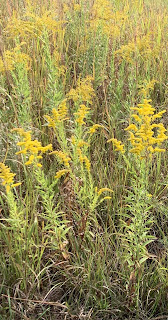Ladies and Gentlemen, boys and girls, dogs and bees, I give you the crowning glory of the Kansas fall prairie, the
Maximilian Sunflower (Helianthus maximiliani). On the prairie near me right now, one can see lots of yellow flowers blooming, foremost being the light-yellow green of the native goldenrods, but nothing outshines or is taller than the Maximilian sunflowers. Standing out hundreds of feet away, each clump betrays the location of a site of disturbed earth, the sunflower a sure marker of soil chaos. Bees and humans alike are drawn to it, the screaming color calling across the ocean of drying prairie grasses.
This clump came up near my burn pile. There's a smaller group in the middle of the unmown area of the back yard (
my so-called "rain garden"), but it is this plant at the back edge of the garden that begs for attention. And, as you can see above, it got attention from this very busy bee photobombing the flower. It also got attention from Mrs. ProfessorRoush, who posed with it for me, but I will not share the beauty of the former in this blog, Internet privacy and all being what it is. I found it interesting that the sunflower and Mrs. ProfessorRoush are almost identical in height, 5 feet tall or so.
The bumblebee that attacked these members of the Aster family was fortuitous for my camera, arriving just as I moved in to photograph the flower closely. In a month these flowers will be bountiful seedheads, full of energy and a good forage crop for livestock and deer.
You can see here what I mean about the goldenrod. I'm not good enough at quick identification to tell you if this is Prairie Goldenrod or Canada Goldenrod or another species, but this is as yellow as it gets and the brightness fades quickly like the plants in the background here.
Between the bad press given to goldenrod, and the happy beaming face of the Maximilian Sunflower, I've got to choose the sunflower every time. And so, it seems do the bees. The only insect I've ever seen on goldenrod around here are the goldenrod soldier beetles.






